Welcome to our guide on infant wrapping! This comprehensive resource will walk you through the safe and effective techniques to swaddle your baby‚ promoting comfort and secure sleep.
What is Infant Wrapping?

Infant wrapping‚ also known as swaddling‚ is a traditional practice where a baby is snugly wrapped in a blanket or wrap to promote comfort and security. This technique involves creating an “X” shape across the back with the wrap‚ ensuring the baby’s arms are gently positioned. The wrap is then brought over the shoulders and secured‚ with the baby’s feet tucked in for a cozy fit. Materials like muslin blankets are popular due to their softness and breathability‚ allowing for natural stretching while keeping the baby warm without overheating. Proper wrapping helps minimize startle reflexes‚ encouraging better sleep and providing a sense of safety‚ similar to the womb environment. It’s a simple yet effective method to soothe and comfort newborns.
Why is Infant Wrapping Important?
Infant wrapping is important for promoting safe sleep and comfort in newborns. It helps minimize the startle reflex‚ which can disturb a baby’s sleep‚ and creates a sense of security reminiscent of the womb. Proper wrapping ensures the baby stays warm without overheating‚ as materials like muslin allow for airflow and natural stretching. This technique also helps regulate the baby’s body temperature and prevents them from breaking free‚ reducing the risk of sleep disruptions. By providing a snug and secure environment‚ infant wrapping encourages better sleep quality and overall comfort‚ making it a valuable practice for new parents to master.
Benefits of Using an Infant Wrap
Using an infant wrap offers numerous benefits for both baby and parent. It provides a snug‚ secure environment that mimics the womb‚ helping the baby feel safe and comforted. The wrap promotes better sleep by reducing the startle reflex and preventing overheating‚ thanks to breathable materials like muslin. It also allows for easy mobility‚ enabling parents to carry their baby while keeping their hands free. Additionally‚ the wrap supports proper body positioning‚ which is essential for healthy development. Many parents find that wrapping helps their baby sleep more soundly‚ leading to less fussiness and a more relaxed environment for the whole family. Overall‚ an infant wrap is a practical and effective tool for fostering comfort and security in newborns.

Choosing the Right Infant Wrap
Selecting the right infant wrap involves considering material‚ size‚ and adjustability. Opt for soft‚ breathable fabrics like muslin to ensure comfort and prevent overheating‚ while ensuring a snug‚ secure fit.

Types of Infant Wraps
Infant wraps come in various styles‚ each offering unique benefits. Muslin wraps are popular for their softness and breathability‚ making them ideal for swaddling. Cotton wraps provide durability and are easy to clean‚ while bamboo wraps are eco-friendly and naturally temperature-regulating. Stretchy wraps allow for flexibility‚ accommodating babies as they grow. Structured wraps with buckles offer simplicity‚ though they may lack the snugness of fabric-only designs. Each type caters to different preferences and needs‚ ensuring parents can choose the most comfortable and practical option for their baby. When selecting‚ consider factors like material‚ adjustability‚ and ease of use to ensure a secure and cozy fit for your little one.
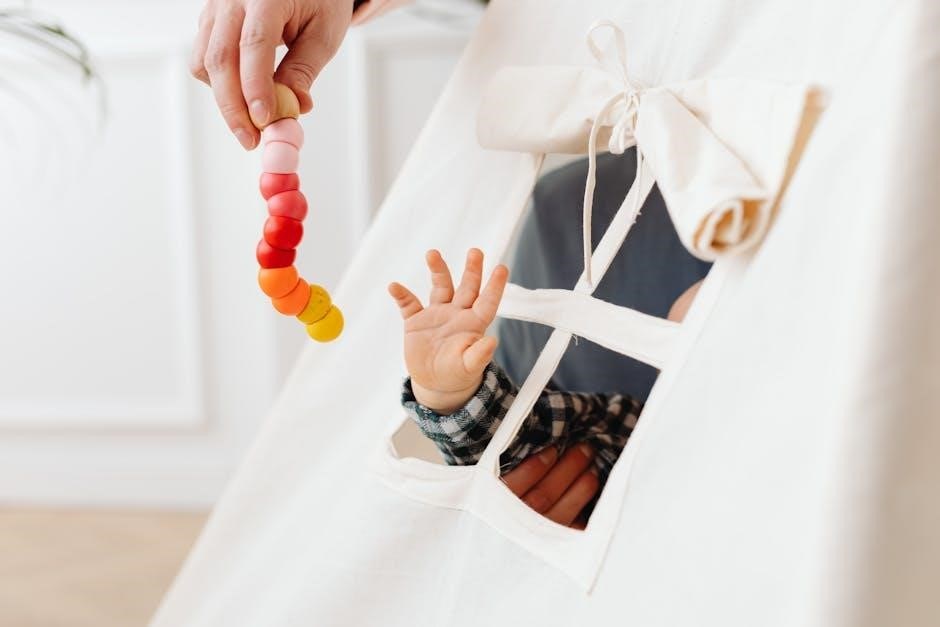
Materials for Infant Wraps
Infant wraps are made from a variety of materials‚ each offering distinct benefits. Muslin fabric is a popular choice due to its softness‚ breathability‚ and natural stretch‚ ensuring comfort and airflow. Cotton wraps are durable and easy to clean‚ making them a practical option for daily use. Bamboo wraps are eco-friendly and lightweight‚ providing excellent temperature regulation for babies. Some wraps also feature blended materials for added softness and flexibility. When selecting a wrap‚ prioritize breathable‚ natural fabrics to promote your baby’s comfort and safety. Avoid heavy or synthetic materials that may cause overheating. The right material ensures a snug‚ secure‚ and cozy fit for your baby‚ supporting their well-being and sleep quality.
Size and Adjustability of the Wrap
The size and adjustability of an infant wrap are crucial for ensuring a comfortable and secure fit. Wraps come in various sizes to accommodate different baby weights and ages‚ allowing for growth and flexibility. Adjustable straps and ties enable customization to your baby’s body‚ ensuring a snug fit without being overly tight. Proper sizing prevents the wrap from being too loose‚ which can compromise safety‚ while adjustability allows for a tailored fit as your baby grows. A well-fitted wrap supports your baby’s natural position‚ promoting comfort and safe sleep. Always choose a wrap that offers multiple adjustment points to ensure it can grow with your baby and meet their changing needs.
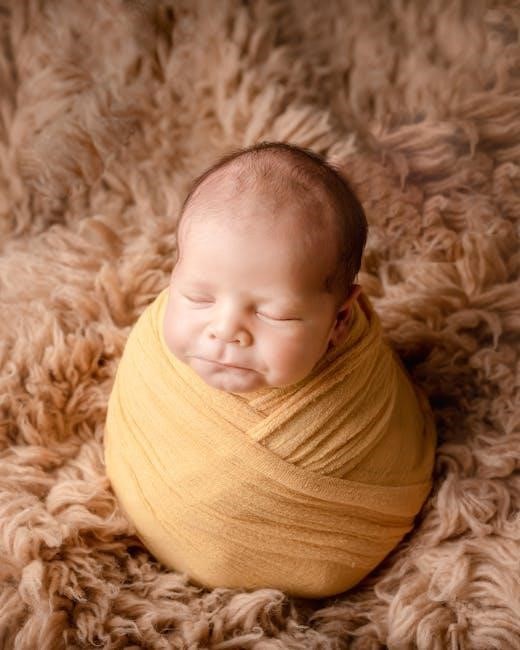
Preparing for Wrapping
Gather all necessary items‚ position your baby correctly‚ and ensure their comfort before starting the wrapping process. This ensures a safe and effective experience for both you and your baby;
Gathering Necessary Items
To begin‚ you’ll need a few essential items to ensure a safe and comfortable wrapping experience for your baby. Start with a high-quality infant wrap or swaddle blanket made from breathable‚ natural fabrics like cotton or muslin. These materials are soft‚ durable‚ and allow for proper airflow‚ which is crucial for your baby’s comfort and safety. Additionally‚ consider having a flat blanket or a lightweight muslin cloth on hand for layering if needed. Avoid using loose blankets that could pose a risk of overheating or entanglement; Ensure the wrap or blanket is the right size for your baby‚ as overly large or small materials can be difficult to manage. Finally‚ gather any additional items like a pacifier or sleep sack if you plan to use them alongside the wrap. Having everything ready will make the process smoother and more enjoyable for both you and your baby.
Positioning the Baby Correctly
Positioning your baby correctly is essential for a safe and comfortable wrapping experience. Start by placing your baby on your shoulder in a burp position‚ ensuring their head is upright and their body is secure. Gently slide one foot into the wrap‚ then transition to the other shoulder and tuck in the second foot; This method helps maintain proper alignment and prevents the baby from breaking free. Always ensure the baby’s hips and spine are aligned naturally‚ with their legs in a frog-like position. Avoid over-tightening‚ as this can restrict movement and cause discomfort. Keep the baby’s airway open by ensuring their face is uncovered and their neck is not compressed. Proper positioning promotes safety‚ comfort‚ and a peaceful experience for your baby.
Ensuring the Baby’s Comfort
Ensuring your baby’s comfort during wrapping is crucial for a positive experience. Use soft‚ breathable materials like muslin‚ which allows for airflow and prevents overheating. Position your baby so their hips and legs are in a natural‚ frog-like position‚ avoiding tight constraints. Keep the wrap snug but not overly tight‚ as this can cause discomfort or restrict movement. Monitor your baby’s temperature and adjust the wrap if they seem too warm. Ensure the baby’s face is uncovered and their neck is not compressed to maintain proper airflow. Regularly check the wrap’s fit and make adjustments as needed to ensure your baby remains comfortable and secure. Comfort is key to a successful wrapping experience.
Step-by-Step Wrapping Instructions
Start by placing the wrap across your chest‚ creating an “X” at your back. Bring the panels over your shoulders‚ tuck in the baby’s feet‚ and adjust for a snug‚ comfortable fit.
Placing the Wrap on Your Body
Begin by positioning the infant wrap correctly on your body. Locate the Beluga Baby tag and place it centered across your chest‚ ensuring the tag faces outward. The wrap should be positioned around your bust area‚ not your waist‚ to ensure proper support and comfort. Gently spread the fabric across your chest‚ making sure it lies flat and even. Next‚ bring the two ends of the wrap behind your back‚ preparing to create the “X” shape that will secure the wrap in place. Adjust the fabric as needed to ensure it feels snug but not overly tight‚ allowing for a full range of motion in your arms. This step sets the foundation for a safe and comfortable wrapping experience for both you and your baby.
Securing the Wrap Across Your Chest
Once the wrap is properly positioned‚ secure it across your chest by bringing the two ends behind your back and crossing them to form an “X.” Ensure the fabric lies flat and evenly‚ avoiding any bunching or twisting. The Beluga Baby tag should remain visible and centered on your chest‚ facing outward. Gently pull the ends to tighten the wrap‚ making sure it feels snug but not overly restrictive. Adjust the fabric as needed to ensure even coverage and comfort. The wrap should support your baby while allowing natural movement of your arms. Properly securing the wrap across your chest is essential for maintaining balance and creating a safe‚ cozy environment for your baby.
Creating the “X” Across Your Back
After securing the wrap across your chest‚ bring the two ends of the fabric behind you and cross them to form an “X” shape. Ensure the fabric lies flat and evenly‚ avoiding any bunching or twisting. Gently pull the ends to tighten the wrap‚ making sure it feels snug but not overly restrictive. Adjust the fabric as needed to ensure even coverage and comfort. The wrap should support your baby while allowing natural movement of your arms. Properly securing the wrap across your chest is essential for maintaining balance and creating a safe‚ cozy environment for your baby.
Bringing the Panels Over Your Shoulders
Once the “X” is formed across your back‚ bring the panels of the wrap over your shoulders‚ ensuring the fabric lies smoothly and evenly. Gently pull the panels forward to create a snug fit‚ making sure the wrap feels comfortable and supportive. Adjust the panels as needed to ensure proper coverage and balance. The wrap should hold your baby close while allowing for natural movement. This step is crucial for maintaining the integrity of the wrap and ensuring your baby remains secure and comfortable. Properly positioning the panels over your shoulders will help distribute the weight evenly and provide the necessary support for both you and your baby.
Tucking in the Baby’s Feet
Gently slide your baby’s feet into the wrap‚ ensuring they are securely positioned at the bottom of the fabric. Tuck each foot into the wrap‚ keeping the legs slightly bent in a natural position. Make sure the feet are not overly restricted‚ allowing for a comfortable and safe fit. The wrap should hold the baby’s feet in place without causing pressure or discomfort. This step helps maintain proper alignment and prevents the baby from slipping downward. Always check that the wrap is snug but not too tight‚ ensuring your baby’s legs can move slightly. This ensures comfort and promotes healthy hip development while keeping your baby secure and cozy in the wrap.
Adjusting the Back of the Wrap
Once the baby is securely placed in the wrap‚ focus on adjusting the back panel for optimal comfort and support. Gently pull the fabric across your baby’s back‚ ensuring it is snug but not overly tight. The wrap should provide even pressure without restricting movement or causing discomfort. Check that the baby’s arms are in a comfortable position‚ slightly bent and not pressed too tightly against their body. Adjust the fabric as needed to ensure proper alignment and support. Make sure the back of the wrap is evenly distributed to prevent any bunching or twisting. This step ensures the baby feels secure and comfortable‚ promoting a safe and restful experience while being wrapped.
Final Adjustments for Comfort and Safety
After securing the wrap‚ perform a final check to ensure your baby’s comfort and safety. Gently tug on the fabric to confirm it’s snug but not overly tight. Ensure your baby’s hips and legs are free to move naturally‚ with knees slightly bent. Check that the wrap isn’t too tight around the chest or arms‚ allowing for proper breathing and movement. Monitor your baby’s temperature to avoid overheating‚ adjusting layers as needed. Ensure the fabric isn’t bunched or twisted‚ especially around the back and shoulders. Make sure the baby’s face is uncovered and there’s ample airflow. If your baby shows signs of discomfort or restriction‚ loosen or reposition the wrap as necessary. These final adjustments ensure a safe and cozy experience for your little one.
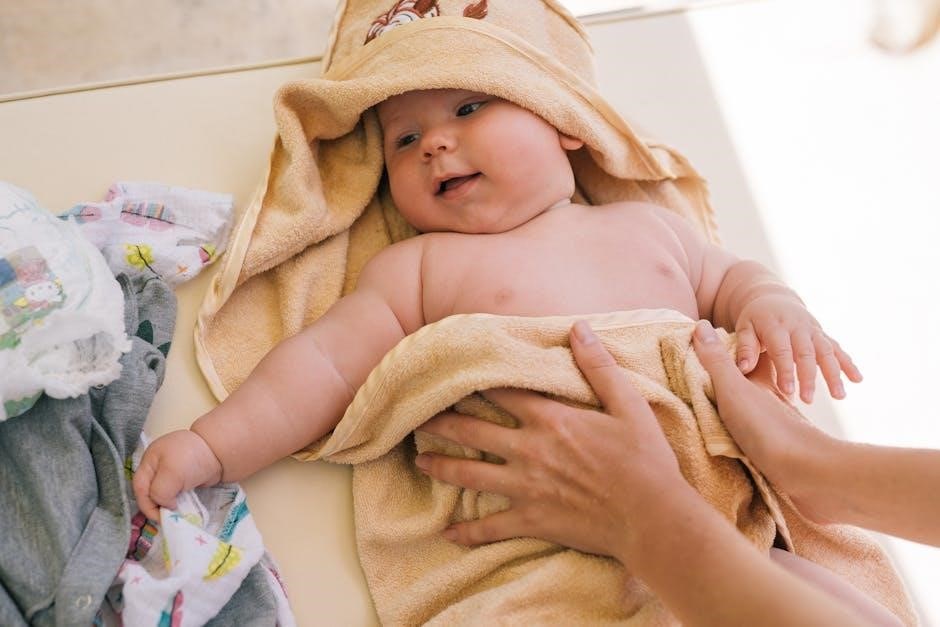
Safety Guidelines for Infant Wrapping
Always ensure proper airflow around your baby’s face and monitor their temperature to prevent overheating. Avoid over-tightening the wrap‚ as it can restrict breathing or movement.
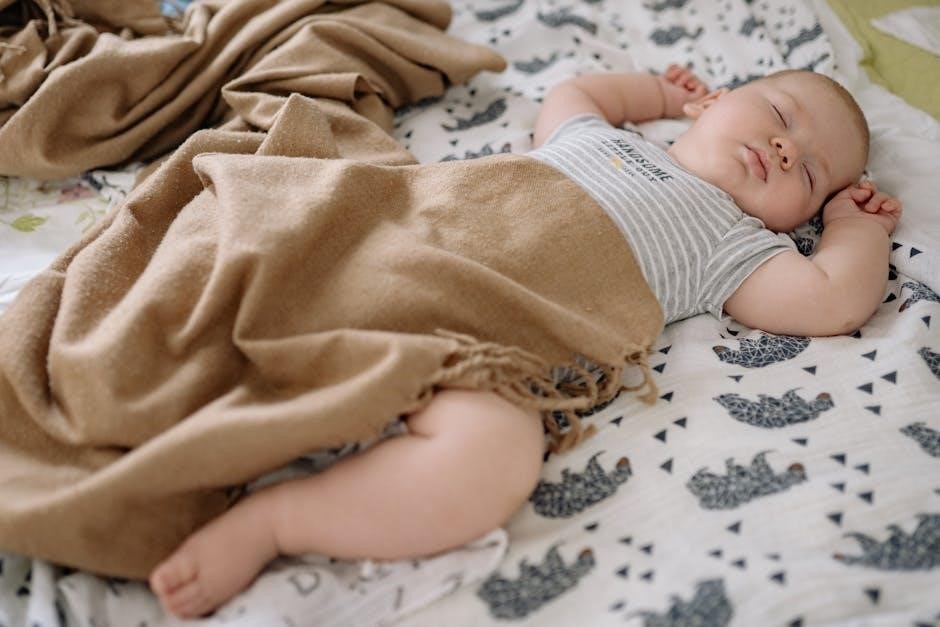
Ensuring Proper Airflow
Proper airflow is crucial for your baby’s safety while wrapped. Use a lightweight‚ breathable fabric like muslin‚ which allows air to circulate and prevents overheating. Avoid covering your baby’s face or head‚ as this can obstruct breathing. Ensure the wrap is not too tight‚ especially around the chest‚ to allow for natural movement and airflow. Keep the baby’s face uncovered and positioned so their nose and mouth are unobstructed. Regularly check on your baby to ensure they are comfortable and not too warm. Muslin blankets are ideal for swaddling due to their soft‚ airy texture‚ which promotes a safe and cozy environment for your little one.
Monitoring the Baby’s Temperature
Monitoring your baby’s temperature while wrapped is essential for their comfort and safety. Check for signs of overheating‚ such as sweating‚ flushed skin‚ or restlessness. Use lightweight‚ breathable fabrics like muslin‚ which allow for airflow and help regulate body heat. Avoid using heavy blankets or excessive layers‚ as this can trap heat. Ensure the room temperature is appropriate for your baby‚ ideally between 68-72°F (20-22°C). Adjust the wrap’s tightness and layers according to the season. Always feel your baby’s chest to gauge their warmth. If they feel too hot‚ loosen the wrap or remove a layer. Regular checks will help maintain a safe and cozy environment for your baby while wrapped.
Avoiding Over-Tightening the Wrap
Avoiding over-tightening the wrap is crucial for your baby’s comfort and safety. A wrap that is too tight can restrict movement and cause discomfort. Use soft‚ breathable fabrics like muslin‚ which allow for airflow and natural stretching. When securing the wrap‚ ensure it is snug but not constricting. Check that your baby’s chest and hips have enough room to move freely; Over-tightening can lead to overheating‚ so monitor your baby’s temperature and adjust layers as needed. If your baby seems restless or sweaty‚ loosen the wrap slightly. Regularly inspect the fit to ensure it remains comfortable and safe. Proper wrapping promotes relaxation without compromising your baby’s ability to move naturally.
Troubleshooting Common Issues
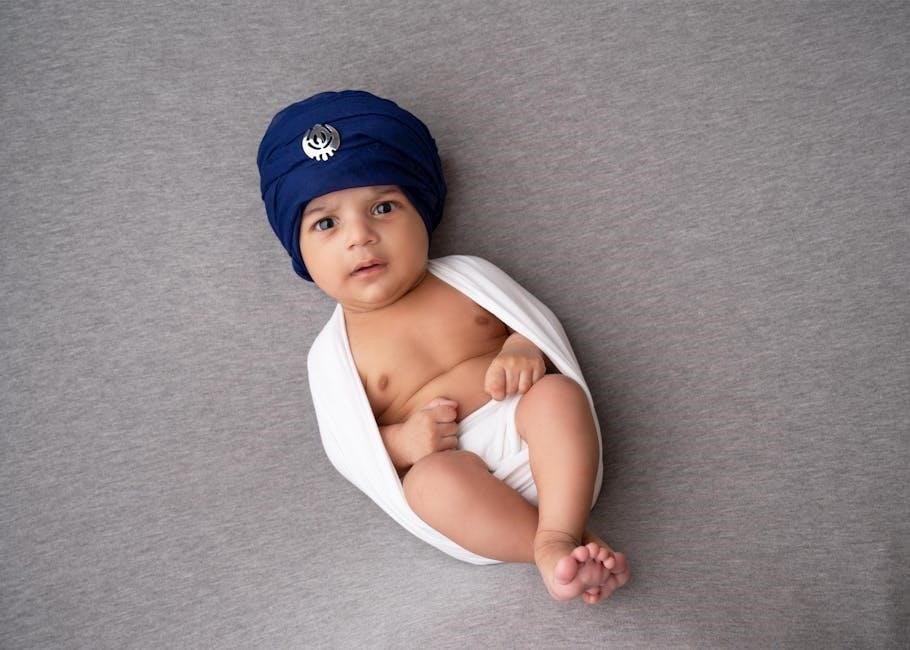
If the baby overheats‚ loosen layers. For a loose wrap‚ re-tighten gently. To prevent escape‚ ensure a snug fit and tuck fabric securely around your baby.
What to Do if the Baby Overheats
If your baby overheats while wrapped‚ immediately loosen the fabric to improve airflow. Remove any extra layers and ensure the room temperature is comfortable. Check for signs like flushed skin or rapid breathing. Gently adjust the wrap to avoid tightness around the chest. Consider using a lightweight‚ breathable material like muslin to regulate body temperature. Monitor your baby closely and take regular breaks to assess their comfort. Ensuring proper ventilation and avoiding over-swaddling are key to preventing overheating. Always prioritize your baby’s safety and adjust the wrap as needed to maintain a cool and secure environment.
Fixing a Loose Wrap
If the wrap feels loose‚ start by adjusting the fabric across your chest and back to ensure a snug fit. Tuck the ends securely under your arms or around your waist. Gently tighten the panels to maintain support without over-tightening. Ensure the baby’s feet are properly tucked in and the wrap is evenly distributed. For added stability‚ cross the fabric over your shoulders and smooth out any wrinkles. If using a muslin blanket‚ its natural stretch allows for easy adjustments. Reposition the baby if necessary‚ ensuring they are centered and comfortable. Regularly check the wrap’s tightness and make adjustments as needed to maintain a secure and cozy fit for your baby.
Preventing the Baby from Breaking Free
To prevent your baby from breaking free‚ ensure the wrap is snug but not overly tight. Tuck the baby’s feet into the wrap and secure the fabric firmly around their body. Use a high-quality muslin blanket‚ as its natural stretch allows for a secure fit without restricting movement. Regularly check the wrap’s tightness‚ especially after feeding or if the baby is active. Ensure the fabric is evenly distributed and the baby is centered. Avoid leaving loose ends‚ as they can unravel and cause the wrap to come undone. Practice the wrapping technique to master a secure fit‚ and consider using a swaddle product for added stability. This will help your baby stay comfortable and safe throughout the day or night.
Additional Tips for Effective Wrapping
Use soft‚ breathable fabrics like muslin for comfort. Ensure a snug fit without over-tightening. Adjust wraps seasonally for warmth and comfort. Practice consistently for mastery;
Using Muslin Blankets for Swaddling
Muslin blankets are an excellent choice for swaddling due to their soft‚ breathable‚ and durable nature. They provide comfort while allowing proper airflow‚ reducing the risk of overheating. The natural stretch of muslin fabric ensures a snug fit without restricting movement. For summer‚ opt for lightweight muslin to keep your baby cool. In colder weather‚ layer muslin blankets for warmth. Always ensure the fabric is clean and free from loose threads. Muslin’s versatility makes it ideal for both novice and experienced parents. By using muslin‚ you can create a safe and cozy environment for your baby‚ promoting better sleep and comfort.
Wrapping for Different Weather Conditions
Adapting your wrapping technique to the weather ensures your baby’s comfort and safety. In warmer weather‚ use lightweight‚ breathable fabrics like muslin to prevent overheating. For colder conditions‚ layer muslin blankets or opt for thicker materials. Always monitor your baby’s temperature; if they feel too warm‚ remove a layer. In summer‚ a single muslin wrap is sufficient‚ while winter may require an extra layer for warmth. Ensure proper airflow regardless of the season to avoid over-insulation. By adjusting your wrapping based on the weather‚ you can create a cozy and safe environment for your baby to sleep peacefully.
Transitioning from Wrap to Independent Sleeping
Transitioning your baby from a wrap to independent sleeping can be a smooth process with patience and consistency. Start by gradually loosening the wrap‚ allowing your baby to get used to the feeling of more freedom. Introduce a sleep sack or lightweight blanket to help them adjust. Ensure the room is at a comfortable temperature and maintain a calming environment. Monitor your baby’s cues‚ as some may transition easily while others may need more time. Be prepared for occasional setbacks‚ but with gentle persistence‚ your baby will learn to sleep independently. This transition supports their growth and helps them develop self-soothing skills‚ making bedtime easier for everyone.
In conclusion‚ mastering infant wrapping offers numerous benefits for your baby’s comfort and sleep security. Keep practicing to ensure a safe and cozy experience for your little one.

Infant wrapping is a valuable technique for promoting safe sleep and comfort. Proper positioning‚ such as placing the baby on their back‚ is essential. Using soft‚ breathable materials like muslin ensures airflow and prevents overheating. Adjusting the wrap snugly but not too tightly is crucial for safety. Regular checks on the baby’s temperature and comfort are recommended. Troubleshooting common issues‚ like loosening the wrap or preventing the baby from breaking free‚ ensures a secure fit. Transitioning to independent sleeping gradually helps the baby adapt. Consistent practice and attention to these details will make wrapping a beneficial and reassuring experience for both you and your baby.
Encouragement for Consistent Practice
Consistent practice is key to mastering infant wrapping. While it may feel challenging at first‚ remember that each attempt brings you closer to comforting your baby effectively. Celebrate small victories‚ like achieving the perfect snug fit or seeing your baby sleep peacefully. Don’t be discouraged by initial difficulties—wrapping becomes second nature with time. Stay patient and focus on your baby’s cues‚ adjusting as needed. The effort you put into learning this skill will pay off in the form of a happier‚ more secure baby. Keep going‚ and soon you’ll be a pro at creating a cozy‚ safe environment for your little one to thrive.
